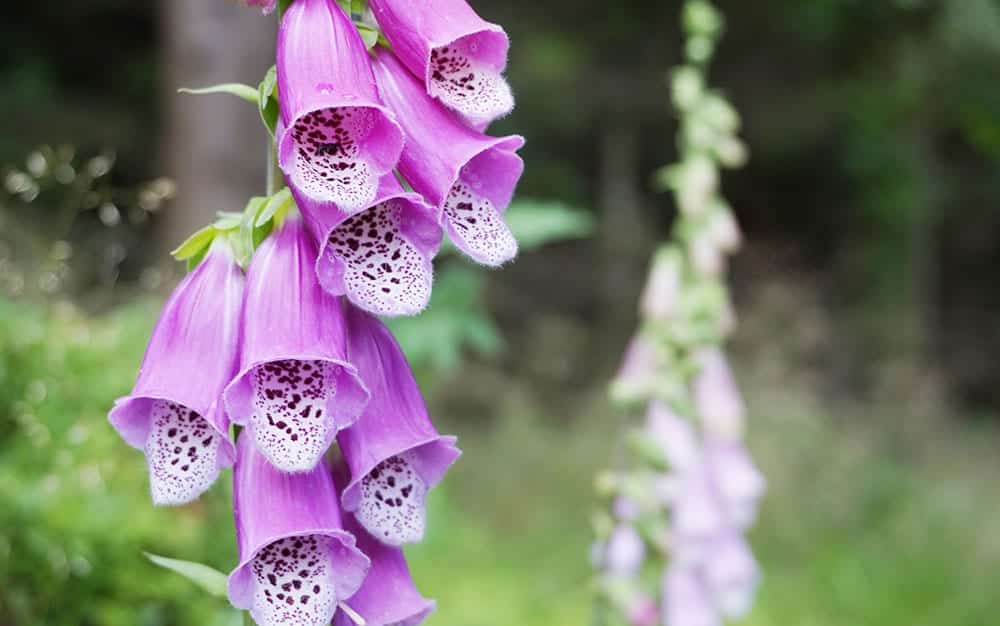The iconic spires of bell-shaped tubular flowers of foxgloves are another popular pick for gardens.
Growing foxgloves
Most foxgloves are biennial, so they grow foliage in the first year, flower in the second year and then die. Our British native Digitalis purpurea is mainly biennial, or sometimes a short lived perennial. However, there are some perennial varieties of foxglove that will flower year after year such as Digitalis x mertonensis.
The best spot to grow them is a position with moist but well-drained soil, with full sun, partial sun, or full shade. Depending on the variety, some will have a higher tolerance for shade.

Caring for foxgloves

Foxgloves flower from May to July, and once flowering is done, deadhead the blooms so the plant can focus its energy into creating a second flush of flowers.
After biennial varieties have set seed, they can be dug up. Although if you remove the spent flowerheads soon after they’ve flowered the plant often produces a second flush of flowers, usually smaller than the first flush and from the sides of the stem. It will also often retain its leaves. On the other hand, perennial types can be cut back around October, ready to flower again next year.
They are low maintenance plants and don’t demand much. Without any extra care, these plants will flower and set-seed.
These beautiful tall plants are self-seeders. So, if you want foxgloves to set seed in your garden, simply leave the flowerheads on the plant until they develop and ripen. Then, the seeds can be collected and scattered where you want the blooms to grow, or sown in a seed tray, or left to naturalise wherever the wind may blow the seeds.
Varieties to grow
Digitalis purpurea (common foxglove)
The British native foxglove is a beautiful woodland plant, and spikes of tubular purple flowers will tower in a border. Not only can you appreciate the blooms but they will also be enjoyed by bees and butterflies.
- Flowers in summer
- Fully hardy
- Grows up to 2.5m tall
- Moist but well-drained or well-drained soil
- Full sun or partial shade
- Exposed or sheltered

Digitalis purpurea (foxglove) ‘Pam’s Choice’
Next is a biennial plant that has white tubular flowers that are marked inside with purple-burgundy speckled colouring. This variety is semi-evergreen with rosettes of foliage that overwinter.
- Flowers in summer
- Fully hardy
- Grows up to 1.5m tall
- Moist but well-drained or well-drained soil
- Full sun or partial shade
- Exposed or sheltered

Digitalis parviflora (small-flowered foxglove)
This perennialfoxglove produces unusual coloured slender small orange brown flowers above lance-shaped foliage, making it an ideal perennial plant to grow amongst low spreading plants.
- Flowers in summer
- Hardy
- Grows up to 1m tall
- Moist but well-drained or well-drained soil
- Full shade, full sun, or partial shade
- Exposed or sheltered

Digitalis purpurea (foxglove) ‘Sutton’s Apricot’
For dainty, pretty soft-pink apricot coloured flowers, this variety is a beautiful choice, especially when grown with peonies. The pastel shade flowers with their soft maroon markings add an elegance to your space and are much loved by bees and butterflies.
- Flowers in spring
- Fully hardy
- Grows up to 1m tall
- Moist but well-drained or well-drained soil
- Full sun or partial shade
- Exposed or sheltered


Leave A Comment